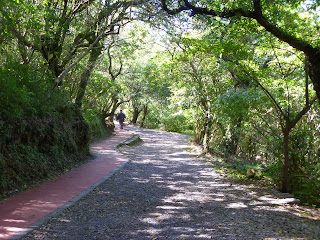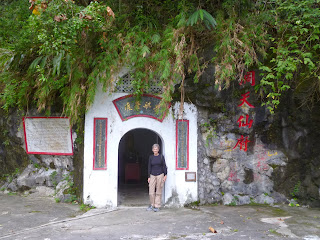Last week we visited Taiwan for 6 days, squeezed between my teaching days. We flew to Taipei, the capital, and after checking into our hotel, we headed immediately to the National Palace Museum. When Chiang Kai Shek fled mainland China, in 1948, he made certain that national treasures from 6 museums were shipped to Taiwan. Many of these had been in crates because he had ordered them moved multiple times in the 1930s when the Japanese invaded China. Not all the crates made it to Taiwan, but we were amazed by the collection. We had visited the Beijing Museum and I had seen the Shanghai one, but this is a much larger collection. There were tons of mainland Chinese tourists there, but we managed to see the whole collection.
Unfortunately, we could not take pictures, but Gallery 304, Uncanny Ingenuity and Celestial Feats was a favorite. We saw some exhibits through the lens of a magnifying glass, and the detail in miniature was truly incredible. We did not miss the Jadeite cabbage from the Qing Dynasty, and that was a good thing. It is the same size as a real cabbage.
 |
| Jadeite Cabbage with Insects |
Later, in the gift shop, we saw multiple iterations of the cabbage--earrings with necklaces to match, large scale replicas as well as small, stationary, rubber place mats, etc. It was clearly the most popular item of the museum! The picture above is from the Internet. Apparently, it will be displayed in Tokyo soon, the first time it has been shown abroad.
The next day we visited the Chiang Kai Shek memorial. It is enormous, with a huge statue of Chiang guarded by soldiers.
 |
| Entrance Gate |
 |
| Palace--not open to the public |
 |
| The statue of Chiang is within this pavilion, opposite the gate above |
 |
| The guards inside the pavilion must hold absolutely still for an hour |
 |
| The statue with the changing of the guard inside the white pavilion |
The changing of the guard was very elaborate and must have taken about 10 minutes.
Another popular tourist sight in Taipei is the Longshan Temple. This was the only temple we visited because we had seen so many recently in Burma!
At the Dihua market we saw well preserved historical architecture and, of course food:
 |
| Half a duck with a head if desired |
 |
| All parts of animals sold are for sale |
 |
| We discovered a French cafe with great coffee. |
 |
A walkway with only one motorbike!
We visited the Shilin night market to taste local specialties--delicious! We chose an item at different stalls, sat down at their rickety little tables, and watched people cook or assemble food we just don't have at home.
|
 |
| Oyster omelets with pancake batter |
 |
| Sausages in a rice-shaped bun with veggies |
 |
| Stinky Tofu |
 |
| Other versions of stinky tofu I could have had! Allen stayed away from this one |
 |
| Squid and octopus soup |
 |
| The night market |
After a full day in Taipei, we went to Yangmingshan National Park, reachable via the subway. You just take a bus that has a circular route around the part, and get off anywhere. Because we can't read or understand Mandarin, we got on a bus that not everyone wanted, and ended up on an express trip half way around the park. We didn't really mind. We took a trail that was the first one built to be accessible to wheelchairs, and ended up in this beautiful valley:
But we went to the park to hike, so we climbed a mountain! You can see it in the background in the picture above.
 |
| Mt. Miantian |
Don't let that .6 km fool you. It was practically straight up!
 |
| We could see Taipei as well as the little village of Danshui we had visited |
 |
| Super Windy up there! |
After three days in and around Taipei, we took a train to Hualien on the beautiful east coast so we could see the Taroko Gorge. Our first day we had time for a bike ride in the park that follows the coast. Just as we reached the whale watching point, it began to rain.
 |
| Allen at the East China Sea |
 |
| The Geisha look (actually sheltering from slanting rain) |
We spent a day at the Taroko Gorge, listed as the number one attraction in our guide book. Its walls are marble, formed 5 million years ago. Allen was trained as a geologist, so we didn't need a guide. The first trail was very easy, so we thought that because visitors have been coming here since the 1930s, all the trails might be quite accessible.
We visited Swallow Grotto, so called because of the holes in the rock:
 |
| The engineering of paths shows the challenges to make these views accessible |
 |
| Wearing hard hats is advised but we didn't have them |
The final spot I will show is very picturesque, and also where we had our most challenging hike: Eternal Spring Shrine.
 |
| You can see this shrine to workers who died constructing the paths from the road, but getting there was a challenge. |
 |
| This inviting suspension bridge led us to a path leading to a pagoda high above the shrine. |
 |
| I'm at the shrine, sweaty, but triumphant |
 |
| Marble boulders |
We were surprised by Taipei. On our walk from our hotel to the subway, we passed 5 coffee shops, Italian, Japanese, Chinese, and American (you know the one). It seemed a lot like Hong Kong with a cosmopolitan feel, big shopping malls (which we avoided), electric taxis, a subway system just like Hong Kong's, and distinctive neighborhoods. There is even the world's second tallest building there.
We were pleasantly surprised by how quickly people walked (here everyone walks in slow motion), how friendly people were, and how considerate they were on the subway. In the subway there were lines painted in the waiting area and people actually stood in them and waited to board. Once in the cars, there were priority seats that were empty if there were no disabled or pregnant women around. I can't count the times people offered us their seats. We have priority seats here in HK, but they're always full. Very few people offer seats to anyone, and racing into the car to get a seat seems to require standing right in front of the doors so that those exiting have to have a strategy.
When I returned to Hong Kong, I told some Chinese friends about the Taipei subway and the considerate behavior of the Taiwanese and one of them said, "ah, but they're not really Chinese!"
Some of them may very well be American. We met two Americans of Taiwanese descent who introduced themselves because they heard our accents.
I told my students that the subway announcements indicated respect to the diverse Taiwanese culture. Every announcement was repeated four times in Mandarin, Taiwanese (Hokkien, a language 75% of the people speak), Hakka (probably about 10% speak it), and English. There are many indigenous peoples in Taiwan also, and we noticed tour buses went to many sites to watch dances and buy woven goods.
The announcements in the subway were similar to HK, but I had to laugh when they said no eating, drinking, chewing gum or betel nut! In Burma, lots of people chew betel nut so their teeth are reddish. Betel nut is a mild stimulant similar to caffeine. Even with this reference to rural culture, in the places we visited, Taiwan seemed very different from the mainland.
One last picture:














































